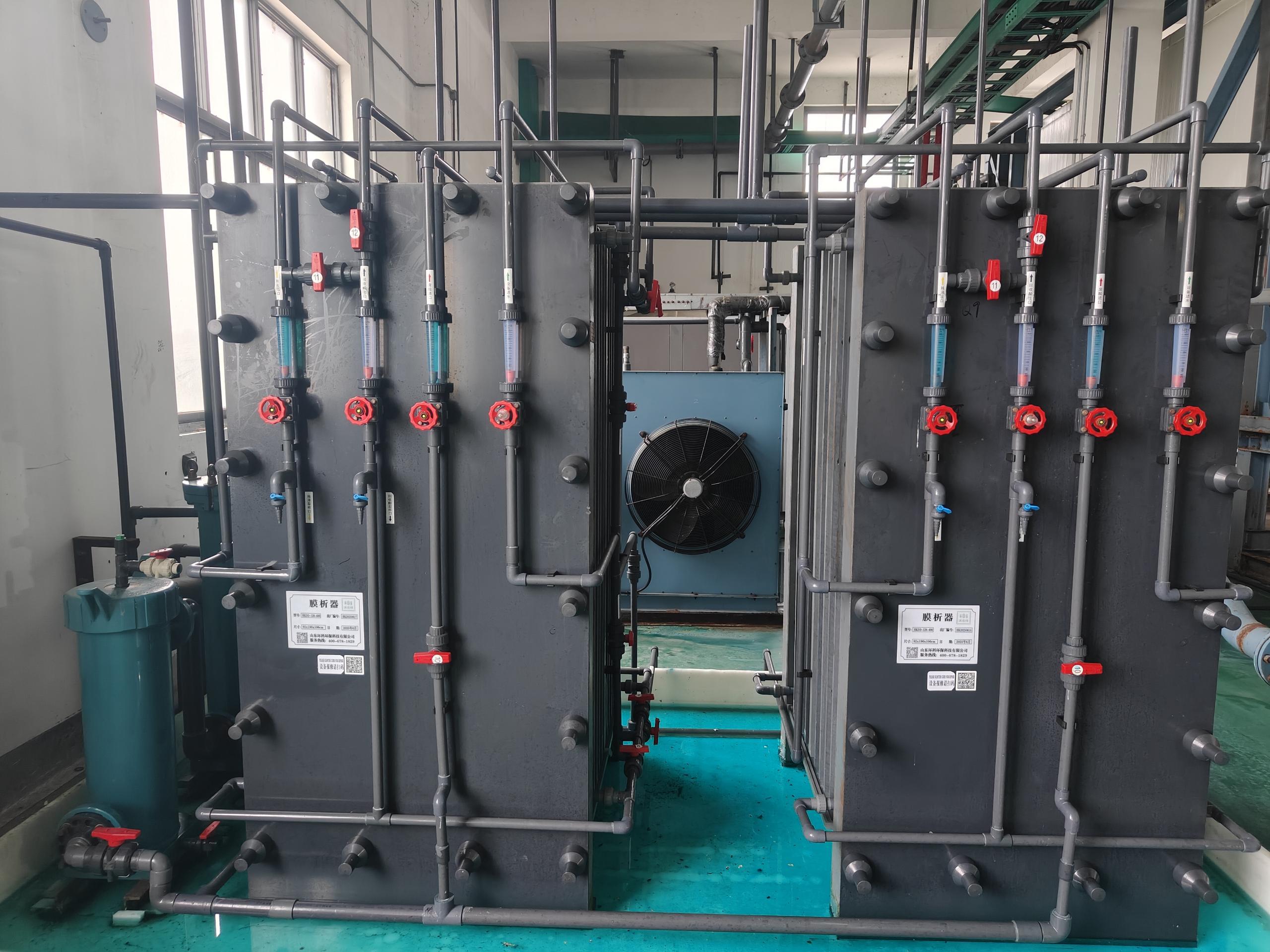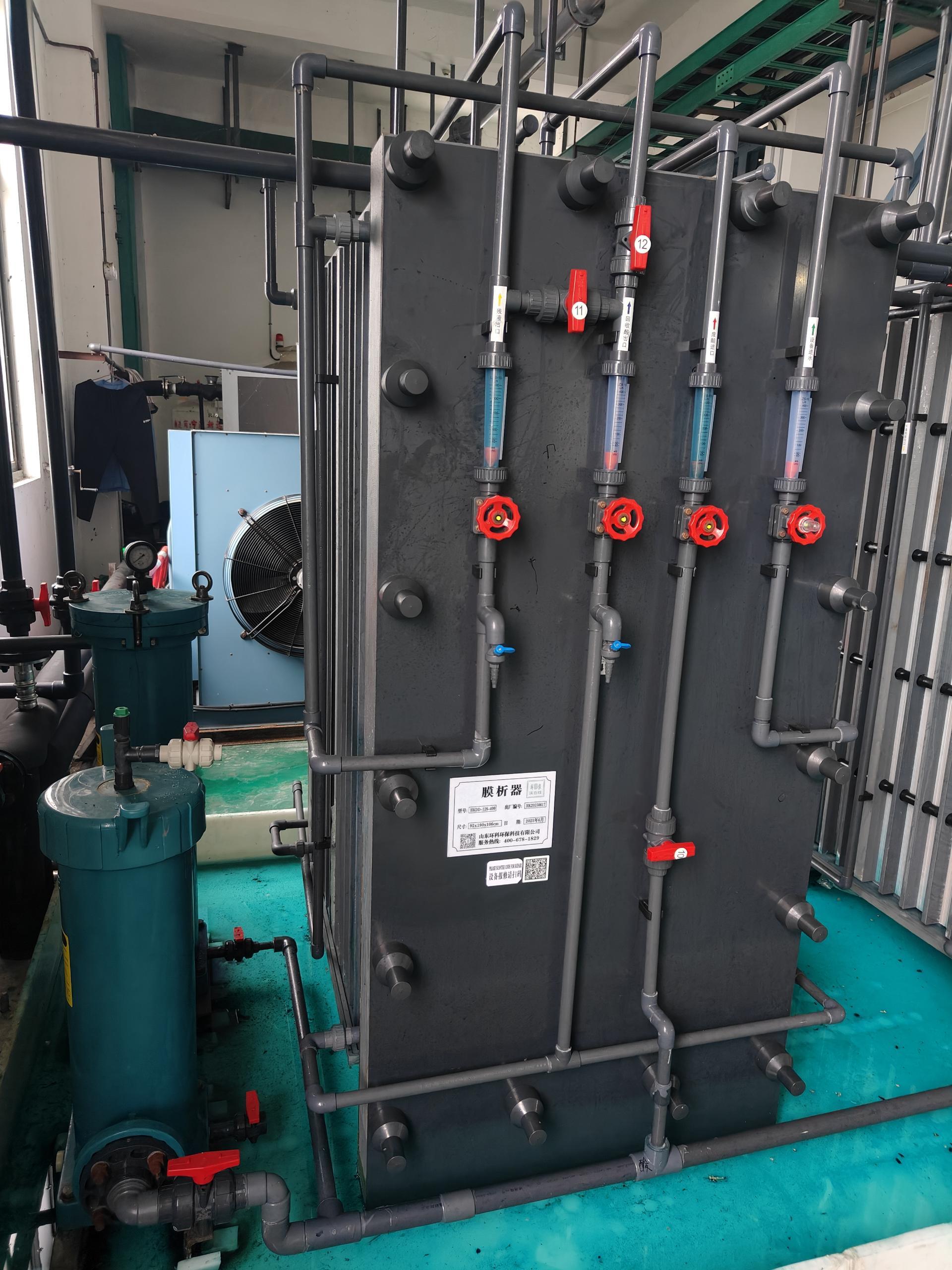15
2025
-
10
Membrane separation - evaporation concentration Synergy: An Innovative Path for the Resource Recovery of Waste Hydrochloric acid Solution
Author:
In fields such as steel pickling, metal surface treatment and chemical synthesis, the large-scale discharge of waste hydrochloric acid not only leads to the waste of hydrochloric acid resources, but also causes environmental pollution and equipment corrosion problems. Although the traditional neutralization method can neutralize acidity, it cannot recover hydrochloric acid and will produce sludge containing heavy metals, increasing the risk of secondary pollution. The combination of membrane chromatography (diffusion dialysis, DD) and evaporation concentration technology can efficiently separate free acids and metal ions from waste hydrochloric acid solution, and concentrate the recovered hydrochloric acid to industrial-grade concentration, achieving the dual goals of resource recycling and pollution reduction. The following text will systematically analyze the innovative application of this combined technology from the aspects of technical principles, process flows, application advantages and future directions.
I. Technical Principle: The synergistic mechanism of membrane evolution and evaporation concentration
1. Membrane chromatography: Acid recovery through concentration gradient Membrane chromatography technology utilizes the selective permeability of anion exchange membranes (AEM) to separate acids from metal ions driven by concentration gradients: • Ion migration: Waste hydrochloric acid solution (high acid concentration) and pure water (low acid concentration) form a concentration difference on both sides of the membrane. Under the action of chemical potential, acid radical ions (such as Cl⁻) migrate to the lower concentration side, while H⁺ is dragged in a coordinated manner due to the association with Cl⁻, ultimately achieving the recovery of hydrochloric acid. • Metal retention: Metal ions such as Fe²⁺ and Zn²⁺ cannot pass through the anion exchange membrane due to the repulsion between their charges and the membrane-fixed groups, thus effectively separating from hydrochloric acid.
2. Evaporation concentration: Thermal energy drives the purification of acid solution. Evaporation concentration involves heating the recovered dilute hydrochloric acid solution to evaporate water and gradually increase the concentration of hydrochloric acid. The core methods include: • Single-effect/multi-effect evaporation: Utilizing the latent heat of steam to achieve efficient concentration, among which multi-effect evaporation can reduce energy consumption by 30% to 50%. • Membrane distillation coupling: By integrating hydrophobic microporous membranes and using temperature differences as the driving force to promote water vapor to pass through the membrane pores, the concentration efficiency is further enhanced.


Ii. Process Flow: Full-chain treatment from waste hydrochloric acid solution to high-purity hydrochloric acid
1. Pretreatment of waste hydrochloric acid solution • Impurity removal and purification: Through air flotation or filtration processes, grease and metal particles in the waste liquid are removed to prevent subsequent membrane module contamination. • pH and composition adjustment: If the waste liquid contains strong oxidants such as HNO₃, Na₂SO₃ should be added in advance for reduction to prevent the oxidants from causing membrane oxidation and degradation.
2. Membrane evolution stage: Recover dilute hydrochloric acid
• Key process parameters: ◦ Membrane module: Select anion exchange membrane (such as Asahi Kasei AEM from Japan); ◦ Feed liquid flow rate: Controlled at 0.5 to 1.5 m/s to balance mass transfer efficiency and membrane fouling risk; Temperature: Maintain at 25 to 40℃ to avoid high temperatures accelerating film aging.
• Core recovery indicators: Hydrochloric acid recovery rate 80% - 85%, recovered acid concentration 4% - 8% (original liquid concentration 10% - 15%), metal ion retention rate > 98%.
3. Evaporation and concentration: Preparation of industrial-grade hydrochloric acid
• Process selection: Single-effect evaporation: Suitable for small-scale treatment, it can increase the concentration of hydrochloric acid to 20% - 25%. Three-effect evaporation: Suitable for large-scale industrial applications, with energy consumption as low as 0.2 to 0.3 tons of steam per ton of water, and the concentration of hydrochloric acid can reach 31% to 36% (meeting industrial-grade standards). • Anti-corrosion measures: The evaporator material is selected from graphite, enamel or titanium alloy to resist HCl corrosion.
4. Residual liquid treatment and resource utilization
Metal recovery: The residual liquid from evaporation (containing high-concentration metal ions) is treated by chemical precipitation or electrolysis to recover metal compounds such as FeCl₂ and ZnCl₂. • Compliant discharge: The pH of the treated wastewater is stable at 6 to 9, and the metal content is less than 1 mg/L, meeting the national discharge standards. Iii. Application Advantages: Triple Benefits of Resources, Economy and Environmental Protection 1. High resource utilization efficiency: The recovery rate of hydrochloric acid in the membrane chromatography stage is 80% to 90%, and after evaporation and concentration, it can reach industrial-grade concentration, which can be directly reused in acid washing, surface treatment and other processes - calculated at a processing capacity of 10,000 tons per year, the enterprise can save over one million yuan in hydrochloric acid procurement costs annually. 2. Controllable operating costs: Membrane chromatography only relies on concentration gradients, and energy consumption can be ignored. Evaporation concentration adopts multi-effect technology, and the cost per ton of water treatment is reduced by 40% to 60% compared with traditional single-effect evaporation. 3. Strong environmental friendliness: It avoids the heavy metal-containing sludge produced by the neutralization method (reducing 0.3 to 0.5 tons of hazardous waste per ton of waste liquid), and the metal recovery rate of the evaporated residual liquid is over 80%, achieving a closed loop of "waste acid reduction - resource utilization". Wide process adaptability: It can handle waste hydrochloric acid solutions with HCl concentrations ranging from 5% to 20% and different metal contents. The modular design facilitates enterprise expansion or transformation of existing production lines.
Iv. Application Cases: Practical Achievements in Industrial Scenarios
Treatment of pickling waste liquid in a large-scale steel enterprise
• Stock solution parameters: HCl concentration 12% - 15%, Fe²⁺ content 3% - 5%, suspended solids 50-100 mg/L;
• Treatment process: Air flotation for oil removal → Sand filtration for suspended solids → membrane separation for recovery (dilute acid concentration 6% - 8%, Fe²⁺ < 0.1g /L) → three-effect evaporation (hydrochloric acid concentration 31% - 33%) → residual liquid oxygenation precipitation for Fe (OH)₃ recovery; • Achievements: The recovery rate of hydrochloric acid is 80%, the recovery rate of metals is 85%, the annual cost of hydrochloric acid procurement is saved by 1.2 million yuan, and the cost of hazardous waste disposal is reduced by 70%.
2. Treatment of copper-containing waste hydrochloric acid in a certain electroplating factory
• Process optimization: Add Na₂S to precipitate Cu²⁺ before membrane chromatography to reduce the risk of membrane fouling; Evaporation and concentration adopt falling film evaporators to enhance heat transfer efficiency.
• Achievements: The purity of recovered hydrochloric acid is over 80%, the content of Cu²⁺ is less than 0.01g /L, the copper recovery rate is over 80%, and high-purity CuCl₂ by-product is prepared simultaneously.
V. Future Outlook: Technological Upgrading and Deepening of Green Manufacturing
Research and development of new membrane materials: Develop high-temperature resistant and anti-pollution anion exchange membranes to enhance the stability of treatment in complex waste liquids; Explore AEM/CEM double-layer composite membranes to achieve the synergistic separation of HCl+H₂SO₄ mixed acids.
2. Evaporation technology innovation: Promote mechanical vapor recompression (MVR) technology, utilize compressors to recover the latent heat of secondary steam, and reduce energy consumption to 0.1 to 0.15 tons of steam per ton of water. Promote the membrane distillation-evaporation coupling process to achieve low-energy consumption and high-concentration hydrochloric acid preparation.
3. Intelligence and System Integration: Develop an AI control system to monitor key parameters such as membrane flux and evaporation temperature in real time and dynamically optimize process efficiency; Build an integrated system of "membrane evolution - evaporation - metal recovery" to achieve full-process automated operation. The synergistic technology of membrane evolution and evaporation concentration provides an efficient and environmentally friendly solution for the resource utilization of waste hydrochloric acid. Through the linkage of acid recovery and concentration, not only can the production costs of enterprises be significantly reduced, but also the discharge of hazardous waste can be decreased, facilitating the green transformation of industry.
In the future, with the continuous breakthroughs in membrane materials and evaporation technology, this combined process will play a greater role in fields such as steel, electroplating, and new energy, providing technical support for the global circular economy and sustainable development.
Related Products
Portable flexible cabin: The "Light Cavalry" for water treatment in Emergency and Remote scenarios
2025-10-31
"Junqi Fang" : An efficient upgrade solution for wastewater biochemical treatment driven by sponge biological fillers
2025-10-29
The Application of Bipolar Membrane Electrodialysis in the Resource Utilization of Lysine Hydrochloride
2025-10-17
Membrane separation - evaporation concentration Synergy: An Innovative Path for the Resource Recovery of Waste Hydrochloric acid Solution
2025-10-15
Huanke Environmental Protection Technology
HOTLINE:
Address:Optoelectronic Industry Accelerator in Weifang Hi-Tech Zone, Shandong Province, China
Contact:Zhang Gong
WhatsApp:+8619953608211
Email:eco.eqpt@gmail.com


Consult

TikTok
Copyright © 2023 Shandong Huanke Environmental Protection Technology Co., Ltd
